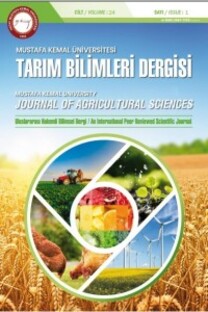Biyoyakıt için mandalina budama atıklarının peletlenmesi
Amaç: Bu çalışmanın amacı, mandalina bahçesi budama artıklarının pelet şeklinde biyoyakıt potansiyelini değerlendirmektir. Yöntem ve Bulgular: Peletler, üç farklı parçacık boyutundan (4, 6 ve 8 mm) ve M10 (% 8 - 10) nem içeriğinde üretilmiştir. Peletlerin bazı ısısal ve fizikomekanik özellikleri güncel AB (Avrupa Birliği) standartlarına göre incelenmiş ve kontrol edilmiştir. Pelet yığın yoğunlukları 474 kg m-3 ile 507 kg m-3 arasında değişirken, pelet yoğunlukları 1230 kg m-3 ve 1270 kg m-3 arasında gerçekleşmiştir. Mekanik dayanıklılık (MD) değerleri %79.46 ile %92.14 arasında, sertlik değerleri 2039.34 N ile 2807.40 N arasında değişmiştir. Kül içeriği %5.64 ve peletlerin alt ısıl değeri 18.66 MJ kg-1 olarak tespit edilmiştir. Genel Yorum: Üretilen tüm peletlerin ölçülen fizikomekanik özellikleri katı biyoyakıt standartları açısından uygun bulunmuştur. Ayrıca, baca gazı emisyonları, çevre koruma için ısıtma yönetmeliklerinde belirtilen sınırlarlar arasında çıkmıştır. Peletlerin ısıl değerleri katı yakıt olarak kabul edilebilir düzeydedir. Çalışmanın Önemi ve Etkisi: Elde edilen sonuçlar, mandalina ağaçlarının budama artıklarının biyoyakıt kaynağı için hem teknik hem de çevresel açılardan uygunolduğunu göstermiştir.
Pelleting pruning residues of mandarin for bio-energy
Aims: This study evaluates the biofuel potential of mandarin orchardpruning residues in the form of pellets.Methods and Results: Pellets were produced at M10 (8 – 10%) moisturecontent, from three different particle sizes (ground by sieves having 4, 6and 8 mm). Some thermal and physical-mechanical properties of thepellets were studied and checked according to the recent EU (EuropeanUnion) standards. Pellet bulk densities varied between 474 kg m-3 and 507kg m-3, while the pellet densities varied between 1230 kg m-3 and 1270 kgm-3 Mechanical durability (MD) values varied from 79.46% to 92.14%.Firmness values changed from 2039.34 N to 2807.40 N. Ash content was5.64% and heating value of the pellets was 18.66 MJ kg-1.Conclusions: The measured physical-mechanical properties of theproduced pellets were in line with the related standards. In addition, fluegas emissions of all the produced pellets were in limits mentioned inheating regulations for the environmental protection aspects for bioenergy resource. Thermal values of pellets are very good as a solid biofuel.Significance and Impact of the Study: Results showed that the pruningresidues of mandarin pruning residues were suitable both in technical andenvironmental.
___
- Anonymous (2017) Food and Agriculture Organization of the United Nations. http://www.fao.org/faostat/en/#home, accessed on May 29, 2017.
- Anonymous (2018) https://biruni.tuik.gov.tr/bitkiselapp/bitkisel.zul Statistics for plant production. Turkish Statistical Institute, Ankara, accessed on May 17, 2020.
- Anonymous (2020) The engineering toolbox. URL: https://www.engineeringtoolbox.com/woodcombustion-heat-d_372.html. Accession date: 06.10.2020
- Celma AR, Cuadros F, Rodriguez FL (2012) Characterization of pellets from industrial tomato residues. Food and Bioproducts Processing 90(4): 700-706.
- EN 15103 (2009) Solid biofuels – Determination of bulk density. European Committee for Standardization: Management Centre, Avenue Marnix 17, B-1000 Brussels
- EN 15210-1 (2009) Solid biofuels – Determination of mechanical durability of pellets and briquettes – Part 1: Pellets. European Committee for Standardization: Management Centre, Avenue Marnix 17, B-1000 Brussels
- EN 14775 (2009) Solid biofuels – De-termination of ash content. European Committee for Standardization: Manage-ment Centre, Avenue Marnix 17, B-1000 Brussels
- EN 14918 (2009) Solid biofuels – De-termination of calorific value. European Committee for Standardization: Management Centre, Avenue Marnix 17, B-1000 Brussels.
- EN 14961-2 (2010) Solid biofuels- Fuel specifications and classes- Part 2: Wood pellets for non-industrial use. European Committee for Standardization: Management Centre, Avenue Marnix 17, B-1000 Brussels.
- EN 15150 (2011) Solid biofuels – Determination of particle density. European Committee for Standardization: Management Centre, Avenue Marnix 17, B-1000 Brussels.
- EN ISO 17225-6 (2015) Solid biofuels -- Fuel specifications and classes -- Part 6: Graded nonwoody pellets. European Committee for Standardization: Management Centre, Avenue Marnix 17, B-1000 Brussels.
- Fasina OO, Sokhansanj S (1996) Storage and handling characteristics of alfalfa pellets. Powder Handling and Processing 8(4): 361-365.
- Holm JK, Henriksen UB, Hustad JE, Sorensen LH (2006) Toward an under-standing of controlling parameters in soft-wood and hardwood pellet production. Energy and Fuel 20: 2686-2694.
- Karaca C (2019) Agricultural residues potential of Hatay. MKU. Tar. Bil. Derg. 24 (Special edition ) :9-15.
- Mani S, Tabil LG, Sokhansanj S (2003) An overview of compaction of bio-mass grinds. Power Handling and Process 15: 160-168.
- Nilsson D, Bernesson S, Hansson PA (2011) Pellet production from agricultural raw materials- a systems study. Biomass and Bioenergy 35: 679-689.
- IKHKKY (2014) Regulations for Air Pollution Control Caused by Burning. http://www.mevzuat.gov.tr/, accessed on January 11, 2019.
- Öztürk HH (2012) Energy plants and biofuel production. Hasad yayıncılık Ltd. Şti, İstanbul, pp: 272.
- Theerarattananoon K, Xu F, Wilson J, Ballard R, Mckinney L, Staggenborg S, Vadlani P, Pei ZJ, Wang D (2011) Physical properties of pellets made from sorghum stalk, corn stoves, wheat straw and big bluesterm. Industrial Crops and Products 33(2): 325-332.
- Tabil LG, Sokhansnj S (1996) Process conditions affecting the physical quality of alfalfa pellets. Applied Engineering in Agriculture 12(3): 345-350.
- Tabil LG, Sokhansanj S (1997) Bulk properties of alfalfa grind in relation to its compaction characteristics. Applied Engineering in Agriculture, 13(4): 499-505.
- Uysan O, Polatöz S (2020) Citrus production in the world and Turkey and froeign trade. https://www.turktob.org.tr/dergi/makaleler/dergi2 2/6-11.pdf, accessed on May 15,2020.
- Werther J, Saenger M, Hartge EU, Ogada T, Siagi Z (2000) Combustion of agricultural residues. Progress in Energy and Combustion Science 26: 1-27.
- ISSN: 1300-9362
- Yayın Aralığı: Yılda 3 Sayı
- Başlangıç: 1996
- Yayıncı: Mustafa Kemal Üniversitesi Ziraat Fakültesi
Sayıdaki Diğer Makaleler
Hamza KUZU, Hayrettin KARADÖL, Ali AYBEK
Some reproductive, fattening and milk yield traits of South Karaman sheep
Dilek TÜNEY BEBEK, Mahmut KESKİN
Pelleting pruning residues of mandarin for bio-energy
Metin DAĞTEKİN, Gürkan A. K. GÜRDİL
Güney Karaman koyunlarının bazı üreme, besi ve süt verim özellikleri
Dilek TÜNEY BEBEK, Mahmut KESKİN
Uşak ilinde arı ürünlerinin tüketim durumları
Nuray ŞAHİNLER, Selçuk ÇETİNKAYA, Nesibe Özge TOY
Biyoyakıt için mandalina budama atıklarının peletlenmesi
Metin DAĞTEKİN, Gürkan A. K. GÜRDİL
Cafer Tayyar ATEŞ, Tülay ÇİMRİN, SEMA ALAŞAHAN
Effects of foliar sulfur applications in cotton crop on stomatal conductance under water stress
